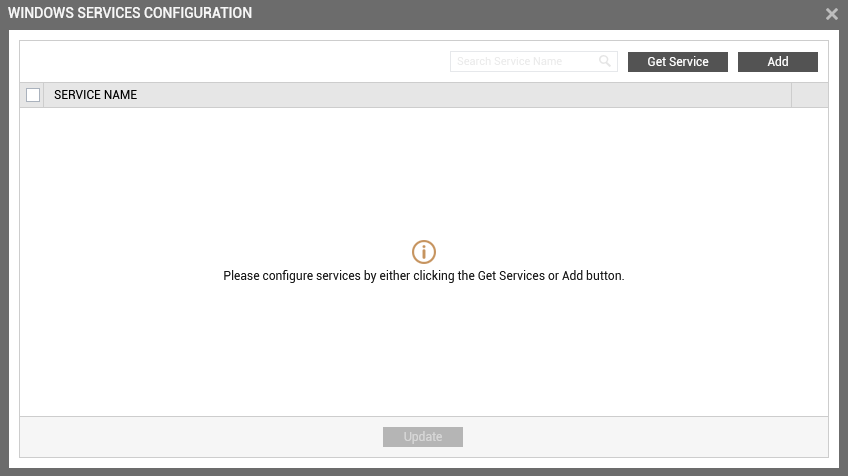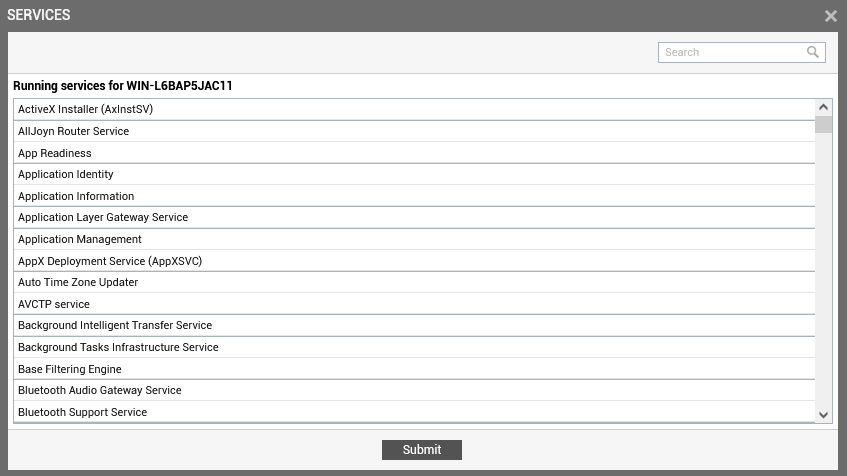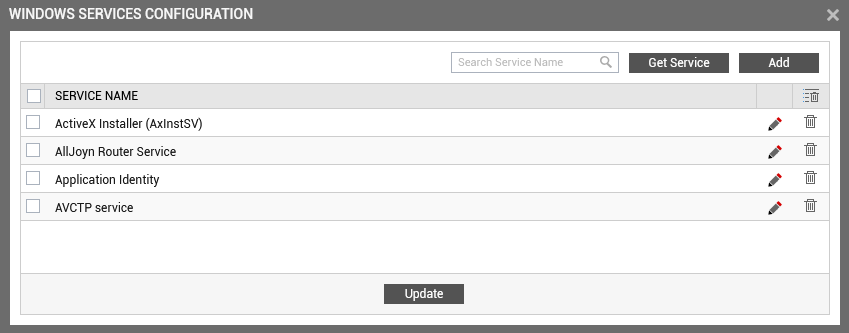Windows Services Test
Many server applications in Windows environments run as background services. The Windows Services test checks the availability of the service that corresponds to an application.
Target of the test : An IIS web server
Agent deploying the test : An internal/remote agent
Outputs of the test : One set of results for every Service name that has been configured.
| Parameter | Description |
|---|---|
|
Test Period |
How often should the test be executed. |
|
Host |
The IP address of the host for which the test is being configured. |
|
Port |
Specify the port at which the target host listens to. |
|
ServiceName |
Name of the service that is to be checked. More than one service name can also be provided with comma as the separator. Note:
To save the time and effort involved in manual service specification, eG Enterprise offers an easy-to-use auto-configure option in the form of a View/Configure button that is available next to the servicename text box. Refer to Auto-configuring the Windows Services to be Monitored for details on how to use this option. |
|
Correct |
Increased uptime and lower mean time to repair are critical to ensuring that IT infrastructures deliver a high quality of service to users. Towards this end, the eG Enterprise embeds an optional auto-correction capability that enables eG agents to automatically correct problems in the environment, as soon as they occur. With this capability, as and when an abnormal situation is detected, an eG agent can initiate corrective actions automatically to resolve the problem. Automatic correction without the need for manual intervention by IT operations staff reduces service downtime and improves operational efficiency. By default, the auto-correction capability is available in the eG Enterprise for the Num_procs_running measure of ProcessTest, and the Availability measure of WinServiceTest. The eG Enterprise includes a default auto-correction script for WinServiceTest, which executes when the service that the eG agent has been configured to monitor, stops. To enable the auto-correction capability of the WinServiceTest, first, select the TRUE option against the CORRECT parameter in this page (by default, FALSE will be selected here). |
|
Is Passive |
If the value chosen is yes, then the server under consideration is a passive server in a cluster. No alerts will be generated if the server is not running. Measures will be reported as “Not applicable’ by the agent if the server is not up. |
| Measurement | Description | Measurement Unit | Interpretation | ||||||||||||||||
|---|---|---|---|---|---|---|---|---|---|---|---|---|---|---|---|---|---|---|---|
|
Service availability |
Indicates the availability of the service. |
Percent |
A value of 100 indicates that the specified service has been configured and is currently executing. A value of 0 for this measure indicates that the specified service has been configured on the server but is not running at this time. A value of –1 indicates that the service has not been configured on the target system. |
||||||||||||||||
|
Service state |
Indicates the current state of this service. |
|
The values that this measure can report and their corresponding numeric values are discussed in the table below:
Note: By default, this measure reports the Measure Values listed in the table above to indicate service state. However, in the graph of this measure, service state is represented using the corresponding numeric equivalents only. |
Auto-configuring the Windows Services to be Monitored
To save the time and effort involved in manual service specification, eG Enterprise offers an easy-to-use auto-configure option in the form of a ![]() icon that is available next to the servicename text box.
icon that is available next to the servicename text box.
To auto-configure the services to be monitored, do the following:
-
Click on the
 icon next to the servicename text area in the Windows Services test configuration page (see Figure 1).
icon next to the servicename text area in the Windows Services test configuration page (see Figure 1).
Figure 1 : Configuring the WindowsServices test
Note:
The
 icon will appear only if the following conditions are fulfilled:
icon will appear only if the following conditions are fulfilled: -
The Windows Services test must be executed in an agent-based manner.
-
In case the eG manager in question is part of a redundant manager setup, then the agent executing the test must be reporting metrics to the primary manager only.
-
-
When the
 button is clicked, a services page will appear (see Figure 2).
button is clicked, a services page will appear (see Figure 2).
-
Upon clicking the Get Service button in the windows services configuration page, a pop up window with a list of services that are running on the host will be displayed (see Figure 3).

Figure 3 : List of auto-discovered services
Note:
The services that have already been configured for monitoring will not be listed in Figure 3.
- From the pop-up, select the services that require monitoring and click the Submit button.
-
Clicking the Submit button in the pop-up will automatically populate the Windows service name text box available in the windows services configuration page, with the name of the chosen service (see Figure 4).

Figure 4 : Multiple auto-discovered services configured for monitoring
-
You can add more services in the windows services configuration page by clicking on the Add button present at the right corner. To remove a specification that pre-exists, just click on the
 icon that corresponds to it. You can also manually edit the service name using the
icon that corresponds to it. You can also manually edit the service name using the  icon. When you click the
icon. When you click the  icon, a window will popup, where you can edit name of the chosen service (see Figure 4).
icon, a window will popup, where you can edit name of the chosen service (see Figure 4).
